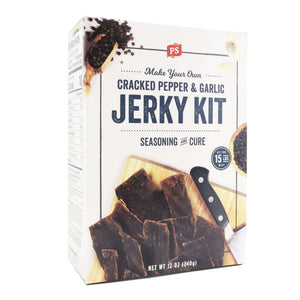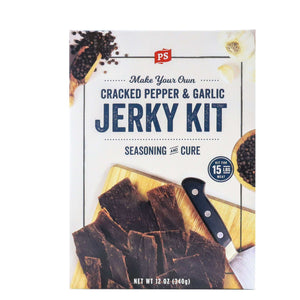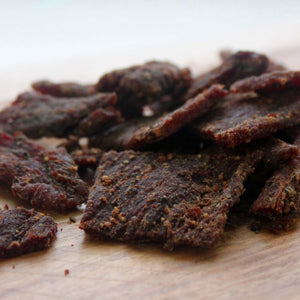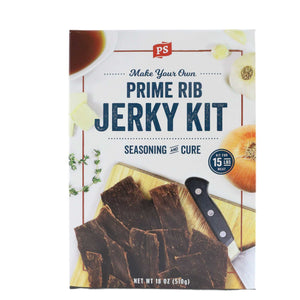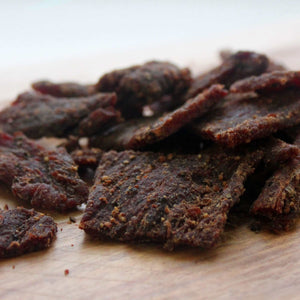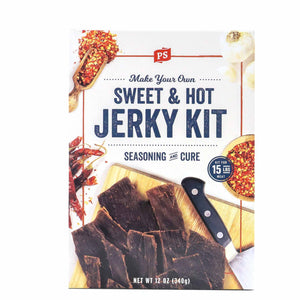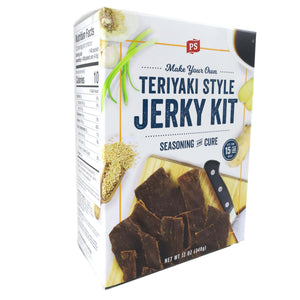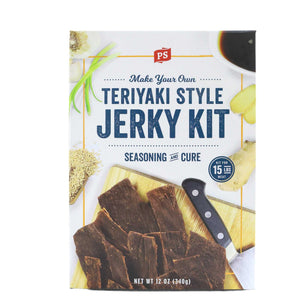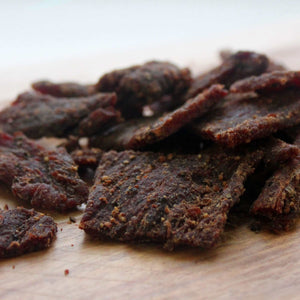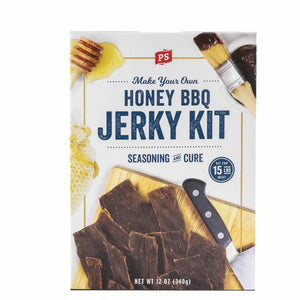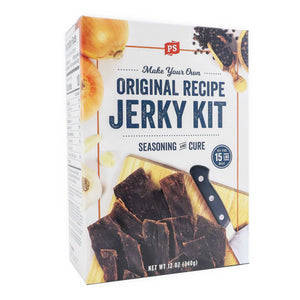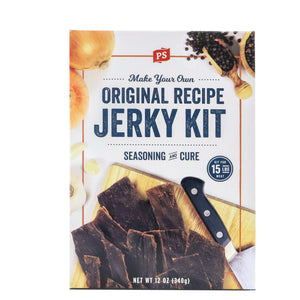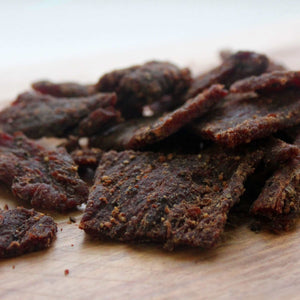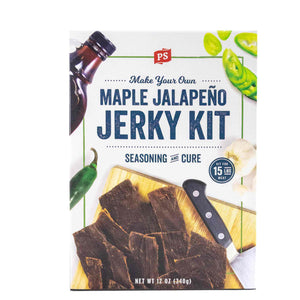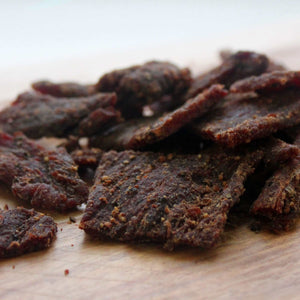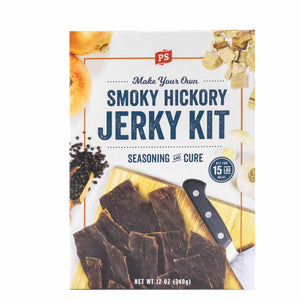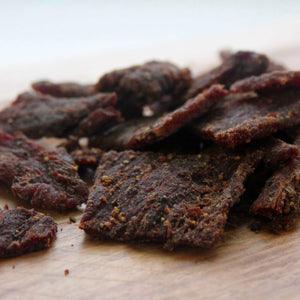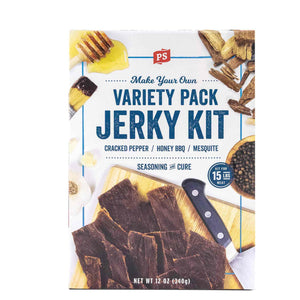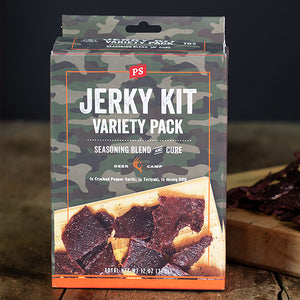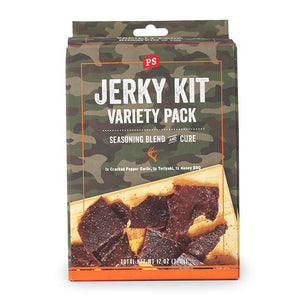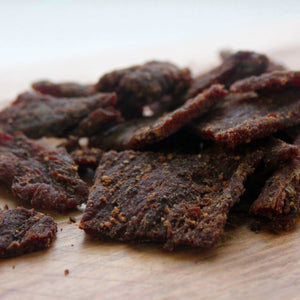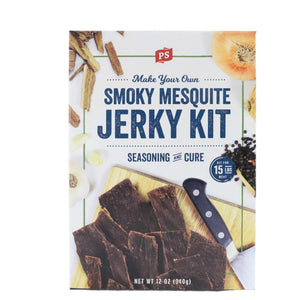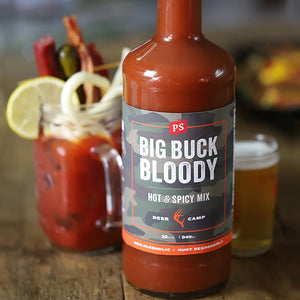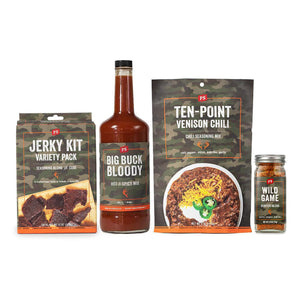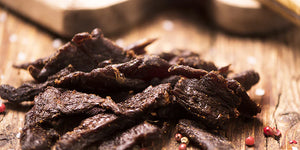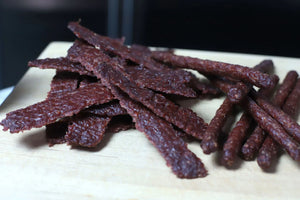12 products
Jerky Making Tips & Tricks
Jerky Making FAQ
Why is Beef Jerky so Expensive
Because of the amount of meat it takes to make, jerky tends to be a bit pricey in shops. On average, you may need between 2 to 2.5 pounds of lean meat to yield 1 pound of jerky after drying. Skip the price tag frustration and the limited flavors by making your own jerky! Wondering how to make beef jerky? Our jerky making kits will help you make enough beef, venison and even vegetarian jerky for any adventure.
How to make beef jerky (or any kind of jerky you like!)
Jerky is one of the most commonly found snack foods in America, and for good reason — it’s delicious. It’s a favorite of families, hikers, campers and meat lovers anywhere.
Making jerky is pretty easy, whether in slice or snack stick form, and you can do it in any number of ways. We even prepared a jerky making guide with no professional equipment required. A PS Seasoning jerky making kit can help you get started on making your own jerky!
What is the best cut of meat for making jerky?
You can use all kinds of meat for jerky as long as it is lean. You can use beef, pork, venison or wild game, ground or sliced. Jerky can basically be made from any lean cut of meat. If your cut of meat is fatty, you’ll want to use a knife and trim the fat off. Fat works against the drying process, and worse, can increase the chance it will go rancid.
While jerky can be made out of any kind of meat, as with all things meat, some types of meat must be treated with more care.
Wild game or pork Jerky:
Making deer jerky is really popular, and for good reason — it’s delicious. Deer and wild game, however, tend to have more bacteria than domesticated animals. So, it is important to use caution. Be mindful of how the game was stored. If it was sitting out at any point after the kill, instead of being rapidly chilled and frozen, it might not be best for jerky. If the animal was wounded during the hunt in such a way that the contents of its gut came in contact with the meat or hunter’s hands while dressing the meat, there could be fecal bacteria contamination. In that case, the safest way to use the meat is not for jerky, but for a type of dish in which it can be thoroughly cooked.
If you choose to use wild game or pork to make jerky, you should treat the meat first in case it contains the Trichinella parasite. This parasite causes trichinosis, a type of roundworm infection. To treat the meat, before it is sliced and marinated for jerky, freeze a portion that is 6 inches or less thick at 5°F or below for 30 days. While this will kill the parasite, it won’t eliminate bacteria from the meat, so be sure to follow other safety guidelines and standard jerky making procedures as well.
Once that's all done and out of the way, you can start making homemade venison jerky with one of our deer jerky making kit for example!
Chicken or Turkey Jerky:
Chicken and turkey jerky are also delicious, although smoked poultry is more popular than raw poultry for texture and flavor. The food safe temperature for poultry is 165°F; keep that in mind as many instructions for jerky use the food safe temperature for beef, which is 160°F. You don’t need to guess — an accurate bi-metallic stemmed food thermometer can help you gauge the temperature.
Can I Use Frozen Meat to Make jerky?
With the exception of wild game or pork, which should be frozen to kill the Trichinella parasite in the manner described above, we recommend that you get the freshest meat possible for your jerky. It will be easier to work with. If you would like to use frozen meat, make sure you defrost it in the refrigerator for safety. Always defrost your meat in the refrigerator to fight bacteria growth when making jerky.
What kind of meat makes for the best jerky?
Here are some of the best cut for beef jerky and other meat cuts that make the cut:
- Beef: Flank, eye of round, top round, bottom round, sirloin tip roast
- Poultry: Tenderloin, breasts (note: If you choose turkey, chicken or other poultry for your jerky, be sure it reaches a food-safe temperature of 165°F (74°C).)
- Pork: Tenderloin
- Venison: Eye of round, rump roast, backstrap
- Fish: Tuna steaks, Salmon (skin and fat removed)
- Ground: Lean, but nothing more than 10% fat
How much meat should i use?
Make sure you buy or provide enough meat. Generally, about 3 lbs of raw meat will produce 1 lb of dry jerky. Each PS Seasoning Jerky Kit is measured for 5 lbs of meat, so expect around 2 lbs of dry jerky.
What is the best jerky seasoning
As flavors go, PS Seasoning has a special jerky making kit geared to the flavors of buttery prime rib, and another for venison. But any jerky seasoning kit will work for any type of meat. With flavors like cracked pepper and garlic, teriyaki, sweet and hot, honey BBQ, maple jalapeno, smoky mesquite, and smoky hickory, we have you covered. (PS Seasoning also has separately sold cures for brining if you want to branch out). No matter which jerky recipe you pick from our selection of jerky making kits, you are going to make a winner homemade jerky!
How to use jerky making kits
PS Seasoning jerky making kits come with jerky seasonings and a cure. That is all you need beyond your meat of choice as ingredients go, whether you’re making jerky out of sliced or ground meat. (In other words, jerky making and snack stick kits are the same thing!) The seasoning and the cure go into the jerky marinade you will use to tenderize, flavor and prepare your meat.
Jerky Seasoning:
Used with cold water, seasoning helps create a delicious jerky marinade. This will tenderize and flavor your jerky. Make sure you use cold water, at about 36-40°F (2°C-4°C). This will help prevent bacteria growth.
Meat Cure:
This also goes into the jerky marinade, and helps your meat stay safer and last longer. It contains additional flavors and nitrites, which are used for meat curing. Curing is important for safety as it inhibits bacteria growth and helps prevent botulism or other foodborne illnesses. Cured jerky will also lengthen the shelf-life of your product. Jerky will last 2 weeks or less if uncured, and for months if cured and stored in a dark, dry place. If using a cure, it's very important that you marinate your meat for at least 8 hours. Do keep the cure out of the reach of children. Making jerky without a cure is possible, but each of our jerky making kits comes with a cure for you to use.
The seasoning, cure and instructions in our jerky making kits have you covered on flavor. Here are a few additional tools that can help you through the jerky making process. A cooking thermometer, especially, is a good investment for a beginner or expert jerky maker alike. These are tools to use if you come to love making jerky snack sticks and homemade jerky pieces on your own.
Meat Slicer (Whole):
A knife does the trick just fine, but for volume and ease of cutting, a meat slicer is a good investment.
Jerky Gun (Ground):
You can use a rolling pin to make snack sticks or rolled-out slices, but again, for uniform sizing, a jerky gun is easier. Most jerky guns have multiple attachments so that the ground meat you load in comes out as flat strips or round sticks.
Wire Racks (Ground or whole):
Wire racks are needed to help your jerky dehydrate in the oven or smoker. If you are using the oven, you can also just place jerky slices on metal skewers and hang them through the top of an oven rack (with a cookie sheet at the bottom to catch drippings).
Cooking Thermometer:
While jerky is not necessarily cooked, it does need to achieve a certain temperature to be safe to eat. 160°F is safe for non-poultry jerky. 165°F is the temperature you want for chicken/turkey/poultry jerky. A bi-metallic stemmed food thermometer can be used to check the temperature while it dries. You can also choose to cook before or after drying to ensure it reaches the proper temperature. USDA and Ohio State University have more resources on how to make your jerky in a safe manner.
Safety tips:
Remember, jerky meat isn’t cooked. So proper handling of the meat before it is cured and smoked is important. Make sure your food prep space is clean and sanitized before you start, and wash your hands for 20 seconds before and after handling raw meat. If your meat is not fresh, and had previously been in the freezer before you began, make sure to thaw it in the refrigerator, not on the counter. Make sure the marinade is cold, between 36-40°F (2°C-4°C). Room temps allow bacteria to grow too quickly. When you are done using your marinade, make sure you throw the excess away; do not reuse it. And don’t skip your cure! Curing jerky helps prevent bacteria growth, as does the method by which you dry it. Cure contains sodium nitrite, which is essential in preserving jerky. Use caution when handling and follow instructions carefully. Keep out of the reach of children.
If you are concerned your jerky, of any kind, hasn’t reached food safe temperatures, try spot-checking with an accurate cooking thermometer. You can also, after it has completely dried, put it in the oven for about ten minutes at 275°F (135°C). You can check and confirm with an accurate cooking thermometer that the jerky has reached a food safe temperature.
With tools, meat and jerky making kit in hand, you’re now ready to get to work and make the ultimate homemade beef jerky!
Check out our “Ultimate Guide to Making Jerky” for information on how you can use a dehydrator, oven, smoker or air fryer to make jerky at home. And be sure to check out all our jerky making kits above for your next culinary adventure. For all things jerky, you can trust PS Seasoning.

